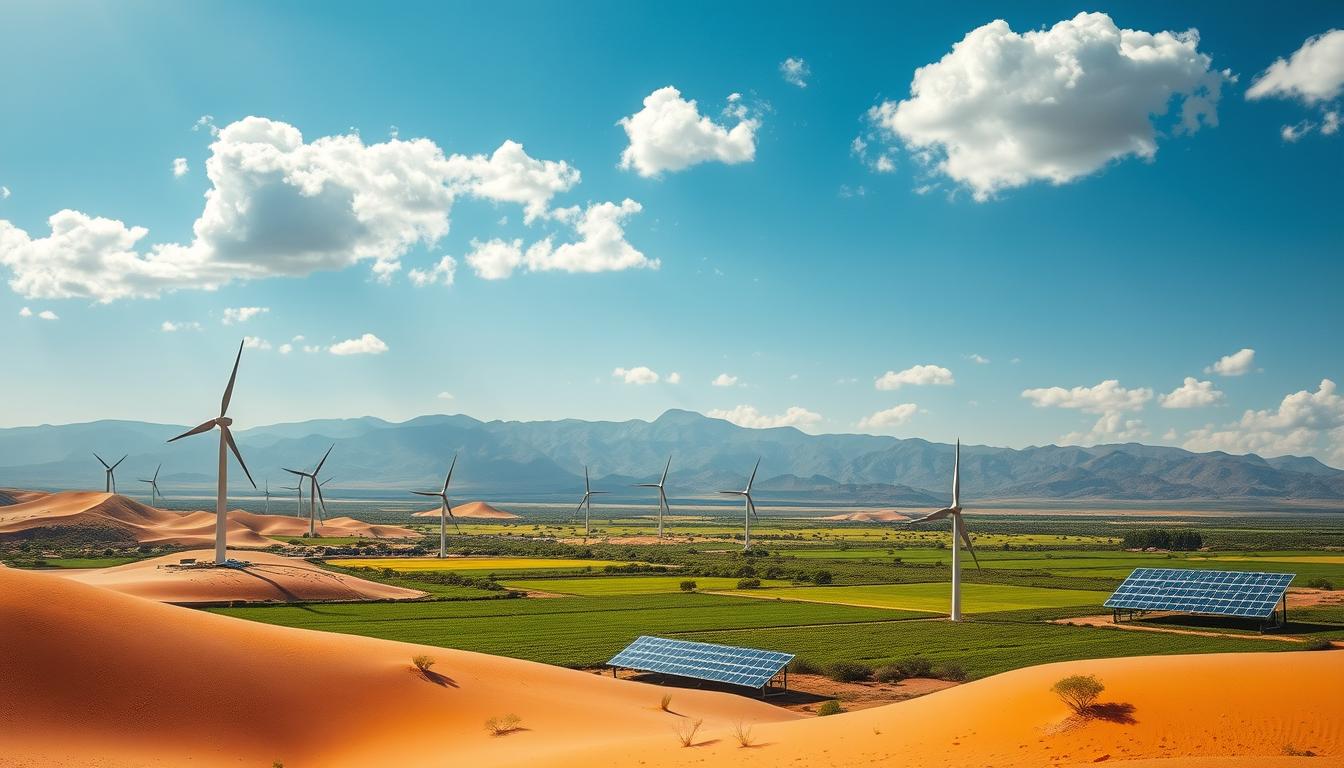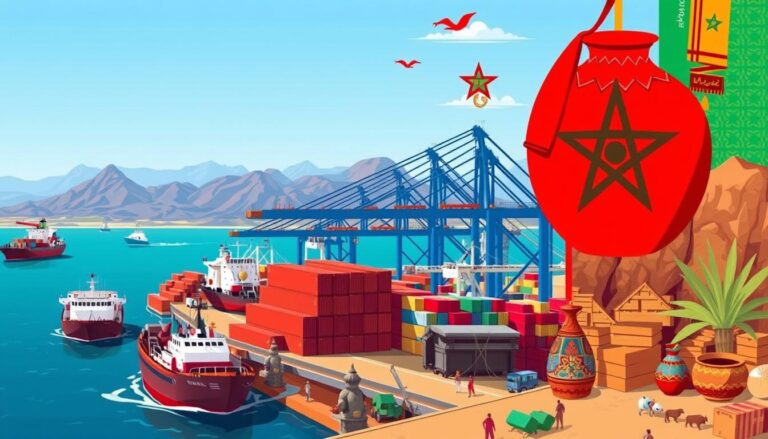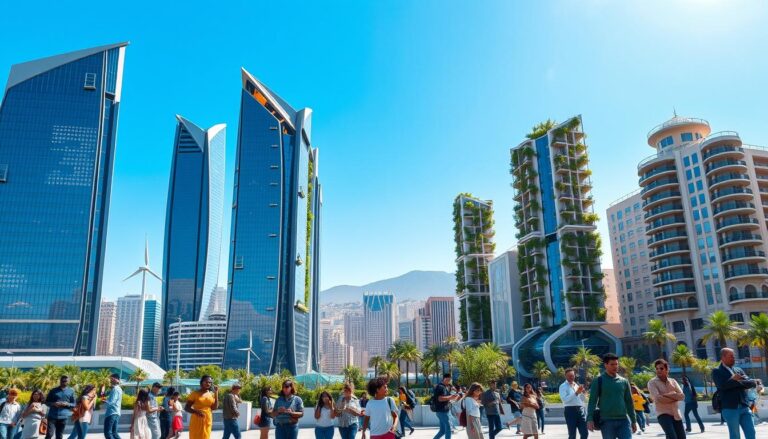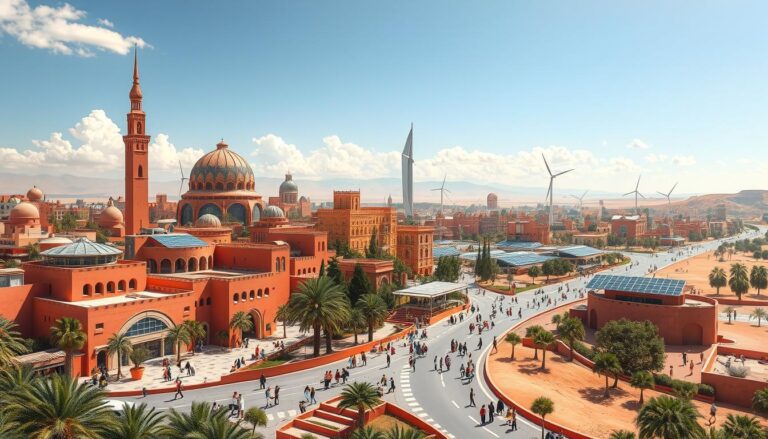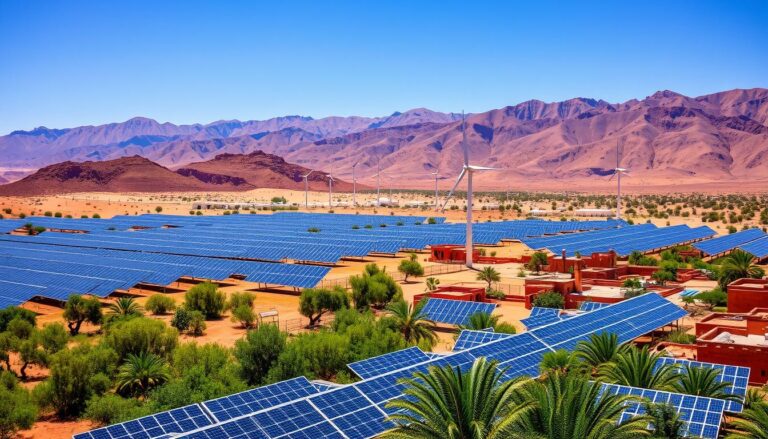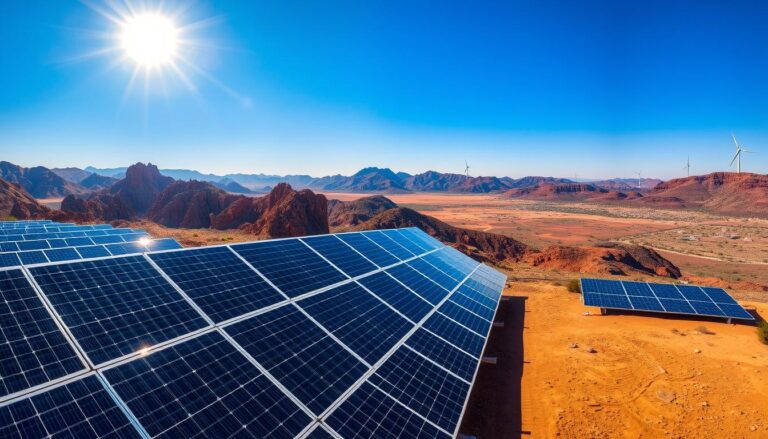Can Morocco use its vast renewable resources to lead in green hydrogen? The world is moving towards sustainable energy, and Morocco is ready. It’s focusing on solar and wind power and starting new green hydrogen projects. But, how will Morocco use its resources and face the challenges of this big energy shift?
Introduction to Morocco’s Hydrogen Economy
Morocco is shifting its energy focus to renewable sources like solar and wind. This move is part of a plan to get 52% of its electricity from green energy by 2030. The country aims to start producing hydrogen from these resources, marking a big step towards sustainability.
Morocco wants to make a lot of green hydrogen. It plans to produce 30 TWh by 2030 and 307 TWh by 2050. To achieve this, it will use 1 million hectares for green hydrogen projects, hoping to attract investors.
Morocco has the right conditions for cheap electricity, key for hydrogen production. It has a strong infrastructure, including a big port and a wide network of roads and rails. This helps it support the hydrogen economy.
The “Morocco Offer” was launched in March 2024 to make the green hydrogen sector more competitive. It offers tax and customs breaks to investors. Working together, public and private sectors will build the needed infrastructure, like power grids and ports.
In summary, Morocco is leading the way in green hydrogen production. Its efforts and strategic plans show it’s serious about being a leader in renewable energy.
The Emergence of Green Hydrogen in Morocco
Morocco is leading the way in green hydrogen, showing its dedication to clean energy. It has set aside about one million hectares for green hydrogen projects. The first 300,000 hectares are for big projects, making Morocco a key place for this clean energy.
What is Green Hydrogen?
Green hydrogen is a clean energy source made by splitting water using renewable energy like solar and wind. This makes it different from hydrogen made from fossil fuels. It’s a carbon-neutral option for the future of energy.
Green Hydrogen vs. Traditional Hydrogen
Green hydrogen is made differently than traditional hydrogen. Traditional hydrogen comes from natural gas, which releases a lot of CO2. Green hydrogen, on the other hand, uses renewable energy for hydrogen production and has no emissions. This shows the big environmental benefits and fits with Morocco’s green goals.
Why Green Hydrogen is Important for Morocco
Green hydrogen is key for Morocco because it helps with energy freedom and protecting the environment. The country has a plan with six main points to support green hydrogen investments. The Moroccan Agency for Sustainable Energy (MASEN) is the main point of contact for investors.
Morocco has 15 years of experience in renewable energy and 32 years in energy investment. This makes it ready to be a leader in green hydrogen.
The plan also includes creating new industries and jobs, and cutting down on greenhouse gas emissions. Morocco wants to be a top exporter of green hydrogen. This will help secure energy for countries in Europe and more.
Renewable Energy in Morocco: A Foundation for Green Hydrogen
Renewable energy in Morocco is key for green hydrogen. The country uses its lots of solar and wind to lead in energy change.
Solar Power Projects
Morocco’s big solar projects are vital for its green energy. The Noor Ouarzazate Solar Complex is one of the biggest. It covers over 3,000 hectares and boosts Morocco’s green energy.
Wind Energy Projects
The Tarfaya Wind Farm on the Atlantic coast shows Morocco’s wind power skills. It’s Africa’s largest, with over 300 MW. Solar and wind projects are key for Morocco’s green hydrogen goals.
Investment in Renewable Infrastructure
Morocco is investing a lot in green energy. The “Morocco Offer” plans to use 300,000 hectares for green hydrogen. They aim to make over 3 million tonnes of green hydrogen by 2030.
Green Energy Initiatives by the Moroccan Government
The Moroccan government is working hard to grow its hydrogen economy. They have a strong policy framework and support systems in place. They want to be a world leader in hydrogen, using their lots of renewable energy.
Policy Framework and Support
Morocco’s hydrogen sector is strong thanks to good policy support for hydrogen economy growth. The government has laws to attract investors in green hydrogen. They offer tax breaks and other benefits for renewable energy and job creation.
They also have programs to help invest in green hydrogen projects. These projects will use public land, making it easier for investors.
National Hydrogen Strategy
Morocco has a big plan for green hydrogen. They want to increase renewable energy to 14.6 GW by 2030 and 131.5 GW by 2050. They plan to spend over $100 billion on this.
They will use solar, wind, and hydroelectric power for hydrogen. By 2030, they hope to get 52% of their electricity from renewables. This will make green hydrogen a big part of their energy mix.
Public-Private Partnerships
Public-private partnerships (PPPs) are key for Morocco’s hydrogen and renewable energy plans. The government has set aside land for green hydrogen projects. They have 300,000 hectares ready for the first phase.
These areas have shared infrastructure like ports and pipelines. Investors will get support if they create jobs and have a big impact. This helps everyone work together for growth and innovation.
Morocco’s government efforts are making big strides in renewable energy. They are becoming a leader in the global hydrogen economy.
Hydrogen Production in Morocco: Current and Future Projects
Morocco is set to become a key player in hydrogen production, thanks to its vast renewable energy resources. The country is using its solar and wind power to start building a strong hydrogen production base. Morocco plans to reach 10 gigawatts of renewable energy by 2030. This could lead to producing up to 1 million tons of green hydrogen every year.
Major Production Facilities
The Noor Ouarzazate solar complex and the Tarfaya wind farm are crucial for Morocco’s green hydrogen goals. These facilities are the core of the country’s renewable energy sector. They provide clean power for hydrogen production. Projects like OCP Group’s aim to produce 200,000 tonnes of green ammonia by 2026 and 1 million tonnes by 2030 show Morocco’s dedication to growing its hydrogen production.
Technological Innovations
Technological progress is key for Morocco’s hydrogen sector. The “Power to Hydrogen (PtX)” project by MASEN is a great example. It combines solar and wind energy in a hybrid power plant with 100 MW electrolysis capacity. Such advancements are crucial for improving efficiency and scaling up green hydrogen production. Investments from global bodies like the European Bank for Reconstruction and Development (EBRD) and the International Finance Corporation (IFC) also support Morocco’s hydrogen ambitions.
Planned Projects and Investments
Future investments in Morocco’s hydrogen sector are expected to grow significantly. Total Energies plans to invest $10.3 billion in hybrid hydrogen and green ammonia production. This investment highlights the global interest in Morocco’s renewable resources and its potential for large-scale hydrogen production. By 2030, Morocco aims to have 52% of its energy from renewables. This goal will increase to 70% by 2040 and 80% by 2050, setting the stage for more hydrogen investments.
Morocco’s journey towards a green hydrogen future is filled with ambitious projects and technological leaps. The focus on innovation and significant investments keeps Morocco at the forefront of the hydrogen revolution. This sets the stage for a sustainable and prosperous energy future.
Export Potential of Green Hydrogen from Morocco
Morocco is becoming a key player in green hydrogen production. Its location near Europe is a big plus for exporting green hydrogen. This makes Morocco a prime spot for sending green hydrogen to other countries.
Strategic Geographic Advantage
Morocco is the closest North African country to Europe. This makes it a natural spot for sending hydrogen to Europe. With its long coastline and good ports, Morocco can handle big shipments of hydrogen.
This strategic spot, along with big plans for renewable energy, puts Morocco at the top of the green hydrogen game.
North African Hydrogen Projects
In North Africa, big projects are underway. For example, OCP Group plans to spend 8.5 billion dollars on green hydrogen and ammonia. This has caught the eye of the world.
Projects like the 8GW green hydrogen plan by HDF Energy and Falcon Capital show North Africa’s lead in hydrogen. The Africa Green Hydrogen Alliance and Air Liquide’s Hyport project in Tangier are also making waves.
Export Infrastructure Development
Morocco is working hard to improve its export infrastructure. It’s upgrading its ports and transport systems for hydrogen. This will help Morocco send more green hydrogen to other countries.
There’s also a plan for a 5,600-kilometer hydrogen pipeline across 11 West African countries. This shows Morocco’s commitment to a big hydrogen network.
Hydrogen Infrastructure Development in Morocco
The development of hydrogen infrastructure in Morocco is key to growing green hydrogen production and use. Morocco has set aside about one million hectares for green hydrogen projects. This includes 300,000 hectares for the first phase, split into smaller plots.
Investors must send detailed plans to MASEN. These plans should show the investor’s financial strength, experience, and how they will benefit Morocco. MASEN checks these plans to make sure they are good for the country and the environment.
The government is also making ports better for handling green hydrogen. They are studying a national hydrogen pipeline network. This network will connect Morocco to Europe, making it a key player in hydrogen trade.
Managing water is also important. Morocco is expanding desalination to meet the water needs of green hydrogen. ONEE is improving the electricity grid to support renewable energy.
Morocco wants to supply over 4% of the world’s green hydrogen by 2030. They are using national clusters to link up the hydrogen industry. This includes ports, pipelines, storage, and a strong electricity grid.
Sustainable transport for hydrogen is a top priority. The process of starting a green hydrogen project is clear and well-organized. This makes Morocco a leader in green hydrogen.
In summary, the development of hydrogen infrastructure in Morocco is crucial for the country’s green hydrogen ambitions. By focusing on sustainable transport and advanced infrastructure, Morocco is set to become a major player in green hydrogen.
Sustainable Energy Solutions and Environmental Impact
Morocco is leading the way in sustainable energy with its green hydrogen sector. These efforts are key to fighting climate change and protecting our environment.
Reduction of Greenhouse Gas Emissions
Green hydrogen is helping Morocco cut down on greenhouse gas emissions. The country is moving away from fossil fuels to green hydrogen. This change is crucial as Morocco’s temperature could rise by over 6.25 °C by 2070-2099.
Decarbonization Efforts
Morocco’s plan to cut carbon emissions is a big part of its climate policy. The goal is to get 52% of its electricity from renewables by 2030. This sets a high standard for the MENA region.
Long-Term Environmental Benefits
Green hydrogen brings more than just lower emissions. It helps with water scarcity, creates jobs, and boosts the economy. Morocco aims to be a leader in renewable energy, making ecosystems more resilient.
By focusing on green hydrogen, Morocco is tackling today’s environmental issues and securing a green future. Its efforts in sustainable energy and decarbonization will benefit future generations.
Investment Opportunities and Economic Impact
Morocco’s green hydrogen economy is booming, offering many chances for investment. This growth will greatly benefit the local and regional economy. Morocco plans to get 52% of its electricity from renewables by 2030. This will change the economy, opening up new investment and job opportunities in the hydrogen sector.
Local Economic Development
Morocco has about 4.6 gigawatts of renewable energy, a strong base for green hydrogen. The country has set aside $2.3 billion for renewable energy from 2023 to 2027. This shows a big step towards economic growth.
The solar sector has drawn around $3 billion in investments. This shows the private sector’s role in boosting local economies. Rural areas have seen better living conditions, thanks to more electricity and water access. This supports sustainable development.
Job Creation
Job creation is a key part of the economic impact. As green hydrogen infrastructure grows, more jobs will be available. Projects like the Noor Ouarzazate Solar Complex and Tarfaya Wind Farm are creating jobs.
New renewable energy projects will need more workers. This will lead to more jobs in different sectors. It will also improve the socio-economic situation of the region.
Regional and Global Investment Interest
Investors from around the world are showing interest in Morocco. Its strategic location and renewable resources attract global investments. In 2022, Morocco saw a lot of foreign direct investment, with the EU being a big part of its trade.
France, the United Arab Emirates, and Spain are among the top investors. The manufacturing sector, which supports renewables, got 23.6% of FDI stocks. This shows how green hydrogen and industrial growth go hand in hand.
Morocco aims to increase private investment to two-thirds by 2035. This shows its commitment to being a key player in the global green hydrogen market. This vision creates a strong environment for green hydrogen investments, driving economic growth and sustainability.
Technological Partnerships and International Collaborations
Morocco is making big strides in the hydrogen economy. This is thanks to its partnerships with other countries. These collaborations help improve how hydrogen is made and used.
Collaborations with Germany
Morocco and Germany teamed up on June 10, 2020, in Berlin. Germany is putting 9 billion euros into hydrogen projects. €2 billion of that is for working with countries like Morocco.
The plant in Morocco will cut carbon dioxide emissions by 100,000 tons a year. This is a big step towards cleaner energy. It’s part of a bigger plan to make energy systems in Europe and North Africa greener.
Global Innovations and Best Practices
At the GH2MoroccoCamp in Benguerir, people came together to talk about renewable hydrogen in Morocco. Out of 300 people who applied, 40 were chosen. Most of them were Moroccan researchers, and over 60% were women.
The top three ideas from this event will get help to make them better. They will also be shown at the World PtX Summit in Marrakech. This shows how important it is to use new ideas from around the world to improve hydrogen technology.
Science and Research Initiatives
Morocco is focusing a lot on science and research for hydrogen. Projects like the MED•GEM Network, funded by the European Union, are working on clean energy for the long term. Working with the International Renewable Energy Agency (IRENA) also helps Morocco grow its green hydrogen.
Research is trying to cut down on greenhouse gas emissions. It’s looking at how hydrogen can be used in different areas. This includes industry, heating, cooking, and even for cars. All these efforts are key to Morocco’s hydrogen plans.
Challenges and Solutions in Morocco’s Hydrogen Economy
Morocco sees a bright future in hydrogen, but it faces big hurdles. High costs and the need for better infrastructure are major challenges. In 2020, Morocco used 33.52 TWh of electricity, growing fast at 5% to 7% each year.
This growth shows the need for energy that’s both efficient and affordable. By 2030, Morocco’s energy needs will jump to over 160 PJ. This calls for big steps in energy production and storage.
Morocco needs to keep innovating, using its huge renewable energy potential. It has 49,000 TWh/year of solar and wind power. Developing strong energy policies and working with private companies is key.
In 2022, Morocco stored about 6.25 GWh of electricity. But, it might face up to 5 TWh of hydropower capacity issues by 2050. This shows the need for varied, strong solutions.
Working with other countries is vital. Morocco can learn from global leaders in hydrogen tech. This can help make production cheaper and boost research.
The Moroccan government is committed to supporting this effort. Its location near Europe makes it a prime spot for exporting green hydrogen. Morocco is set to be a big player in the global green hydrogen market. This will help cut carbon emissions and grow the economy through new jobs and investments.
Source Links
- Morocco
- A Critical Analysis of Morocco’s Green Hydrogen Roadmap: A Modelling Approach to Assess Country Readiness from the Energy Trilemma Perspective
- Morocco and the Future of Green Hydrogen
- Morocco’s emergence as a green hydrogen leader – African Association of Entrepreneurs
- Morocco: Green hydrogen – the Moroccan Offer
- Morocco’s Revolutionary Green Hydrogen Offer – CASCI
- Morocco’s Role in Global Green Hydrogen Economy – Green Hydrogen News
- Morocco’s Strategic Move in the Green Hydrogen Sector: Unveiling the "Morocco Offer"Article
- Green hydrogen: ‘L’Offre Maroc’ receives 40 project applications
- Morocco Green Hydrogen Offer – key takeaways
- Morocco – Energy
- Four Reasons Why Morocco Is Becoming a Renewable Energy Powerhouse
- Morocco’s green hydrogen offer and opportunities for investors
- Financing Green Hydrogen Projects in Morocco and Chile – REGlobal – Finance
- Just Energy Transitions? Lessons From Oman and Morocco
- Morocco’s potential to export green hydrogen to Europe faces challenges
- Energy Circle
- MASEN – Offre Maroc Hydrogène Vert
- Morocco’s path to a climate-resilient energy transition: identifying emission drivers, proposing solutions, and addressing barriers
- Investment Opportunities in Morocco’s Energy Sector
- Morocco’s Long Road Toward Economic Transformation
- Morocco – United States Department of State
- Innovation & Collaboration at the Heart of the First Green Hydrogen Morocco Camp – EU Neighbours
- Morocco Collaborates with IRENA to Accelerate Hydrogen Transition & Boost Renewable Green Energy – Morocco Travel Blog
- MOROCCO: Partnership with Germany for green hydrogen

The Editorial Team is a passionate group of Morocco enthusiasts dedicated to sharing the beauty, culture, and wonders of this captivating country. With diverse backgrounds and a deep love for travel, we strive to bring you engaging and informative content that inspires your Moroccan adventures. From uncovering hidden gems and sharing local insights to exploring mouthwatering cuisine and showcasing the vibrant lifestyle, our team is committed to providing you with valuable resources and exciting stories that enhance your exploration of Morocco. Join us on this journey as we celebrate the rich heritage and unforgettable experiences that make Morocco truly special.

